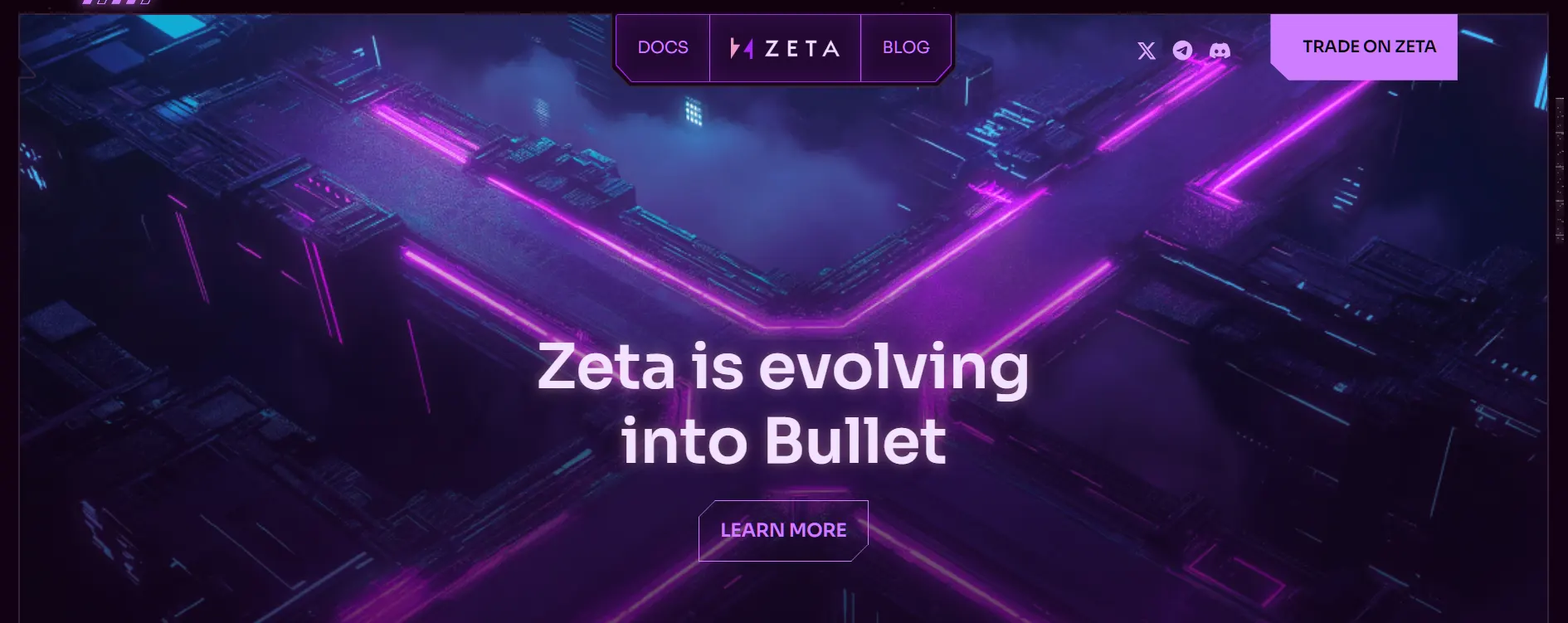Zeta Markets — a decentralized exchange for perpetual futures on the Solana blockchain, built to combine the speed of CEX platforms with the transparency of DeFi. The platform became one of the first to fully implement a central limit order book (CLOB) on Solana, offering traders a familiar interface and low fees. In 2025, the project announced a relaunch as Bullet — a network extension designed to execute trades with latency under 2 milliseconds. This transformation marks the shift from a standalone DEX to a full-scale infrastructure layer for high-frequency trading in Web3.
- Zeta Markets: Concept and Development
- Architecture and Trading Model
- ZEX Token Economy
- Bullet: Transition to the New Network
- Market Outlook and Significance

Zeta Markets: Concept and Development
Zeta Markets emerged as a decentralized platform for derivatives trading on Solana. Its primary goal was to provide users with self-custody, transparency, and execution speed comparable to centralized exchanges. Unlike AMM models, Zeta adopted a CLOB architecture, ensuring precise order execution and a traditional trading experience.
Since launch, Zeta quickly joined the ranks of leading Solana-DeFi protocols, processing billions in trading volume. The team integrated Pyth Network oracles and implemented cross-margin systems with unified collateral. However, as trading volumes grew, network limitations like transaction conflicts and latency spikes appeared. These challenges motivated the transition to Bullet — a new architecture providing deterministic latency and scalable performance.
Architecture and Trading Model
The Zeta Markets trading engine was built around an on-chain order book with near-instant execution. The team aimed to bring CEX-level performance to decentralized trading without compromising transparency. Zeta’s hybrid architecture combined Solana’s high throughput with smart contract risk management, ensuring resilience and precision.
Before exploring the list, it’s worth noting that Zeta’s model included liquidation systems, oracles, fee mechanisms, and incentive layers. Below are the core principles behind its structure.
Key Features of Zeta Markets:
- CLOB Architecture — orders and books processed entirely on-chain.
- Perpetual Futures — contracts without expiry linked to spot price.
- Low Fees — 0.10% for takers and 0.02% for makers.
- Liquidation System — automated, powered by Pyth Network.
- Referral and Staking Programs — rewarding active users with ZEX tokens.
- Unified Collateral Pool — multi-asset margin support.
This structure made Zeta one of the most technically advanced DEXes in the Solana ecosystem. Yet, the limitations of Solana’s L1 required a new path forward — leading to Bullet.
ZEX Token Economy
The ZEX token played a core role in Zeta’s ecosystem. It governed the protocol, enabled staking, provided rewards, and served as a participation mechanism. Token holders could earn fee shares, vote on proposals, and benefit from incentive programs. Following Bullet’s announcement, ZEX became the migration asset — holders receive equivalent BULLET tokens at a 1:1 ratio.
Before viewing the table, note that ZEX tokenomics was designed for long-term sustainability and a balanced ecosystem between traders, investors, and the community. It encourages participation and reduces reliance on short-term speculation.
| Parameter | Description / Value |
|---|---|
| Total Supply | 1,000,000,000 ZEX |
| Rewards for Traders and LPs | 10% (airdrops and incentives) |
| Team and Investors | 38% (vested) |
| Community Treasury | 22% for ecosystem development |
| Migration Mechanism | ZEX → BULLET (1:1) |
| Role in Bullet | Governance, staking, gas fees |
This structure preserved economic continuity between Zeta and Bullet, ensuring user confidence and value stability.
Bullet: Transition to the New Network
Bullet became the natural evolution of Zeta Markets, marking Solana’s step toward specialized network extensions. It’s not a “version 2.0” DEX but a dedicated execution layer maintaining Solana’s security. Bullet employs its own sequencer and zk-proofs while using Celestia for data availability.
The network’s main goal is sub-2ms latency infrastructure for market makers and HFT bots operating fully on-chain. The ZEX → BULLET migration is underway, and the testnet shows improved throughput and predictable performance under heavy load.
Market Outlook and Significance
Bullet’s emergence reflects Web3’s shift toward domain-specific infrastructure: trading, gaming, and DePIN. Unlike general-purpose blockchains, Bullet focuses on deterministic execution and speed consistency.
In Solana’s derivatives sector, competitors like Hyperliquid and Drift remain strong, but Bullet’s architectural edge lies in low latency and pro-grade infrastructure. If successful, it could anchor Solana’s on-chain derivatives market and set a new benchmark for real-time blockchain trading.




